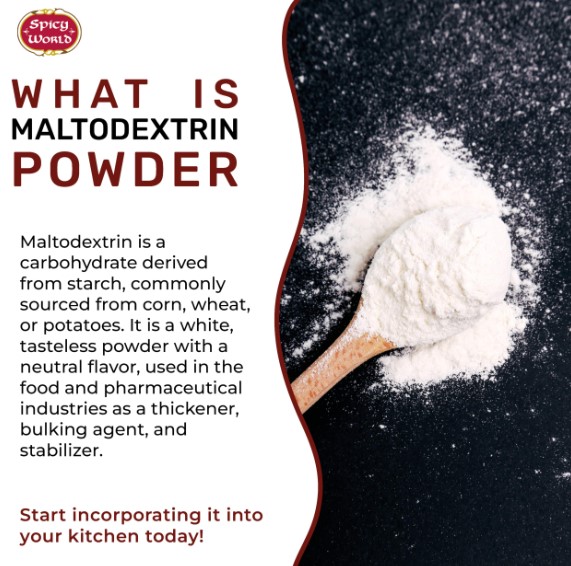BOURSESSENEGAL – Maltodextrin is a commonly used ingredient in various food products, but many people don’t fully understand what it is or how it affects their health. This polysaccharide, derived from starch, is often found in processed foods, energy drinks, and supplements. In this article, we’ll explore what maltodextrin is, its uses, potential benefits, and considerations for those looking to incorporate it into their diets.
What is Maltodextrin?
A Quick Overview
Maltodextrin is a white powder that is produced from the hydrolysis of starch. It’s made from various sources, including corn, rice, potato, or wheat. This ingredient is created through a process that breaks down the starch into smaller carbohydrate molecules. It is highly soluble in water and has a mild, slightly sweet taste.
How It’s Made
The production of maltodextrin involves cooking the starch source, followed by the addition of enzymes or acids. This process breaks the starch down into shorter chains of glucose. Once the desired level of sweetness and viscosity is achieved, the maltodextrin is dried and powdered.
Uses of Maltodextrin
1. Food Industry Applications
Maltodextrin is widely used in the food industry for various purposes:
Thickening Agent
One of its primary roles is as a thickening agent. adds body and texture to sauces, soups, and gravies. It helps improve the mouthfeel without significantly altering the flavor of the product.
Sweetener
While not as sweet as sugar, maltodextrin serves as a sweetener in many processed foods. It is often used in low-calorie or sugar-free products as a sugar substitute.
Preservative
Maltodextrin can act as a preservative, extending the shelf life of products by preventing moisture absorption and maintaining freshness.
2. Sports and Nutritional Supplements
Maltodextrin is popular among athletes and fitness enthusiasts for its energy-boosting properties.
Quick Energy Source
Due to its high glycemic index, maltodextrin provides a rapid source of energy. It’s often included in sports drinks and energy gels to replenish glycogen stores during intense workouts.
Facilitating Nutrient Absorption
In some supplements, maltodextrin acts as a carrier for nutrients, making them easier for the body to absorb. This enhances the effectiveness of the supplement.
Health Benefits of Maltodextrin
1. Energy Boost
If you engage in strenuous exercise or endurance sports, maltodextrin can provide the quick energy you need. Its rapid absorption makes it a favorite among athletes seeking immediate fuel during workouts.
2. Easy Digestion
Maltodextrin is easy to digest and may be suitable for those with digestive issues. Unlike some complex carbohydrates, it does not cause bloating or discomfort.
3. Versatile Ingredient
Maltodextrin’s neutral flavor and versatility allow it to be used in a wide range of products, making it easier to find foods that fit your dietary needs.
Considerations and Potential Drawbacks
1. High Glycemic Index
One of the primary concerns with maltodextrin is its high glycemic index (GI). Foods with a high GI can cause rapid spikes in blood sugar levels. For individuals with diabetes or those looking to manage their blood sugar, this can be a significant consideration.
2. Allergies and Sensitivities
While maltodextrin is generally safe, some people may experience allergic reactions, especially if it is derived from wheat. Those with celiac disease or gluten sensitivity should avoid sourced from wheat.
3. Lack of Nutritional Value
Maltodextrin lacks essential vitamins and minerals. It serves primarily as a carbohydrate source but doesn’t provide the nutrients found in whole foods. Relying too heavily on-based products may lead to nutritional imbalances.
How to Incorporate Maltodextrin into Your Diet
1. Read Labels
When purchasing packaged foods or supplements, check the ingredient list for maltodextrin. Being aware of what you consume can help you make healthier choices.
2. Use in Moderation
If you choose to use maltodextrin in your diet, do so in moderation. Balance your intake with whole foods that provide essential nutrients and fiber.
3. Explore Alternatives
If you’re concerned about the effects, consider alternatives. Other carbohydrate sources, such as oats, sweet potatoes, and quinoa, can provide energy without the potential drawbacks.
Conclusion: Is Maltodextrin Right for You?
can be a useful ingredient in various contexts, particularly for athletes or those needing quick energy. However, understanding its properties and potential effects is crucial for making informed choices.
Weighing the Benefits and Risks
While offers benefits, such as quick energy and ease of digestion, it also comes with considerations regarding blood sugar levels and nutritional value. It’s essential to weigh these factors and consider your individual health goals.
Making Informed Choices
Ultimately, whether to include in your diet depends on your specific needs and lifestyle. Always consult with a healthcare professional if you have concerns or questions about incorporating new ingredients into your diet.
By understanding and its role in health and nutrition, you can make choices that align with your wellness goals. Whether you’re an athlete looking for a performance boost or someone simply trying to navigate food choices, knowledge is your best ally in making informed decisions.
REFERENCE : KAWAN77



